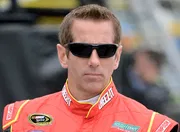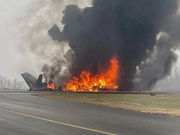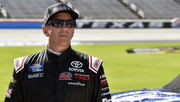
Imago
Aug 31, 2023; Charlotte, North Carolina, USA; Kevin Harvick answers questions from the media at Charlotte Convention Center. Mandatory Credit: Jim Dedmon-USA TODAY Sports

Imago
Aug 31, 2023; Charlotte, North Carolina, USA; Kevin Harvick answers questions from the media at Charlotte Convention Center. Mandatory Credit: Jim Dedmon-USA TODAY Sports
Drivers who start at the apex of the pack should always get their advantages, right? After all, it is with hard work and considerable effort that one can get to the front. The NASCAR system has been ruining the pole sitter’s advantage for quite some time now. With recent incidents that serve as a testimony, it is indeed time that NASCAR takes up active measures.
Watch What’s Trending Now!
Kevin Harvick has always been one name who has never shied away from expressing his opinion to NASCAR. He continues to share how the pole sitters often do not have an advantage. This often forces the drivers to choose not to make pit stops on certain tracks.
ADVERTISEMENT
Harvick breaks down how the pole sitter loses out on a big advantage
After working through the trials and ensuring the best qualifying time, one ascertains the pole position. This puts the driver at an advantage so that they have an edge over the others. However, such is the current NASCAR system that takes away the advantage of the pole sitter. Instead, drivers might just find themselves in the same standing. Now, what are these timing lines? Instead of placing a limit such as 50 mph for the pit road, what NASCAR does is keep checkpoints in the form of timing lines across the entirety of the pit road.
Hence, drivers don’t have to go at a constant speed throughout the track. If their pit stall is after many timing lines, they can drive slowly before pitting, and then simply speed up after their pit stop is done, as they can manage the overall average. Thus, the first pit stall gets the biggest disadvantage. For each racetrack, the timing line is placed at a varied distance from the first pit stall. This pushes the advantage that the pole sitter is originally supposed to have. The disparity at every track with this distance can hamper the ultimate speed pickup.
Citing this issue, Kevin Harvick mentioned, “The flaw in the NASCAR system is that the speed line from the end of the first occupied box should be the same distance at every track. This would ensure that the car with the pole qualifying position, which picks the first pit stall, truly has an advantage. Currently, at tracks like Charlotte, cars barely have to get out of their stall to pass the first timing line, whereas at other tracks, like Las Vegas, the first pit stall doesn’t offer much benefit. Without a standardized distance from the first occupied stall to the timing line, teams might not choose the first pit stall at tracks with green flag pit stops because they can’t gain an advantage by reaching full speed in time.”
ADVERTISEMENT

ADVERTISEMENT
The lack of standardization with the distance across tracks adds to the perils. At Charlotte Speedway the first pit stop is very close to the timing line. Consequently, this makes the teams not want to choose the first pit stop as happened on Sunday. Christopher Bell, even after starting from the pole position, did not opt in for the stop as this would have directly impacted the speed of the car.
To combat this issue, Harvick pinpoints how NASCAR has been negligent about the disadvantage that such a system puts forth. He suggests ensuring the distance from the first pit stall to the timing line is the same for every track. This would help the team at the pole position to get an advantage, irrespective of the track. It can also guarantee that the one who is in the pole position can make use of the advantage instead of the same being just a namesake. Harvick added, “Standardizing the length of the distance from the first occupied box to the timing line at every racetrack would make the system fairer and ensure that the pole position gains a consistent advantage week after week.”
ADVERTISEMENT
Top Stories
NTSB Appeals for Greg Biffle’s Wife’s Alleged In-Flight Text Messages as Crash Investigation Heats Up

Donald Trump Issues Moving Message of Condolence for NASCAR’s Greg Biffle & Family During North Carolina Address

Another Almost Fatal Disaster Surfaces From Statesville Airport Amidst Ongoing Greg Biffle’s Crash Investigation

Air Safety Investigator Probes Possible Co-Pilot Role Amid Greg Biffle’s Fatal Plane Crash Investigation

Greg Biffle’s Haunting Aviation Admission Resurfaces Hours After Tragic NC Plane Crash

Harvick suggests Homestead Miami as the Championship race track
The next round of the playoff will see the top 8 contenders battling through their way at the 1.5-mile Homestead Miami track. With a higher bank towards the wall, the track allows multiple options for side-by-side battles and racing grooves. While Homestead was originally the battleground for the Championship, in 2020 the tracks changed to Phoenix.
This happened after the track went through a major renovation. NASCAR veteran Kevin Harvick however speaks about the supremacy that the Miami track holds. He mentioned, “I hope at some point we start a cycle in these Championship races from Phoenix to Homestead even if it’s just those two racetracks. I really hope that we get back to that because Homestead is just such a unique place. You have to run up against the wall.”
ADVERTISEMENT

Getty
HOMESTEAD, FL – NOVEMBER 15: A general view as the sun sets during the NASCAR Nationwide Series Ford 300 at Homestead-Miami Speedway on November 15, 2008 in Homestead, Florida. (Photo by Jamie Squire/Getty Images for NASCAR)
The current track has seen Championships from 1999 and each of the 267 laps is filled with mystery. Harvick also suggests a consecutive switch between Homestead and Phoenix as Championship trackways. This would add a new course of obstacles for the drivers and inch them closer to dealing with complexities on track. But that is what the final race should be about right?
The beauty of Homestead Miami is that this track can make unexpected things happen. Do you think that this time too the track will witness an unusual event?
ADVERTISEMENT
ADVERTISEMENT
ADVERTISEMENT
ADVERTISEMENT

